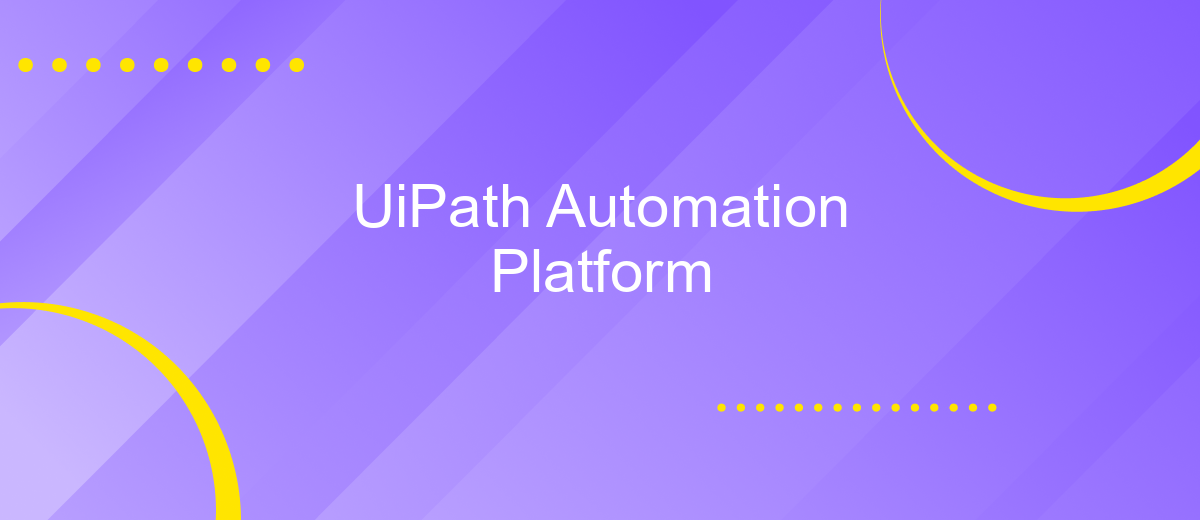UiPath Automation Platform
The UiPath Automation Platform is revolutionizing the way businesses approach process automation by offering a comprehensive suite of tools designed to streamline operations and enhance productivity. By leveraging cutting-edge technology, UiPath enables organizations to automate repetitive tasks, reduce human error, and free up valuable resources for more strategic initiatives. This platform empowers users to achieve greater efficiency and drive innovation in an increasingly competitive market.
Introduction
UiPath Automation Platform is revolutionizing the way businesses approach process automation by providing a comprehensive suite of tools designed to streamline operations, increase efficiency, and reduce costs. As organizations strive to remain competitive in a rapidly evolving digital landscape, the need for scalable and robust automation solutions has never been more critical. UiPath offers an integrated platform that empowers users to automate repetitive tasks, enhance productivity, and drive innovation across various industries.
- Seamless integration with existing systems and applications
- User-friendly interface for both technical and non-technical users
- Advanced AI and machine learning capabilities
- Comprehensive analytics and reporting tools
- Scalability to meet the demands of growing businesses
By leveraging UiPath Automation Platform, organizations can transform their operations and achieve significant improvements in performance and agility. This platform not only simplifies the automation journey but also ensures that businesses can adapt to changing market conditions with ease. As digital transformation continues to shape the future of work, UiPath stands at the forefront, offering solutions that are both innovative and practical.
UiPath Products and Services

UiPath offers a comprehensive suite of products designed to streamline and enhance automation processes across various industries. At the core of its offerings is the UiPath Studio, a powerful tool that enables users to design automation workflows with ease, using a drag-and-drop interface. Complementing this is UiPath Orchestrator, which provides centralized management of robots, facilitating scheduling, monitoring, and deployment of automation tasks. For those looking to automate repetitive desktop tasks, UiPath Robot is an essential component, executing processes with speed and precision.
In addition to its core products, UiPath provides a range of services that support integration and scalability. UiPath Connect Enterprise facilitates seamless integration with existing enterprise systems, enhancing workflow efficiency. For businesses seeking to integrate multiple applications without complex coding, services like ApiX-Drive can be invaluable. This platform simplifies the connection between UiPath and various third-party applications, ensuring smooth data flow and process automation. Together, these products and services empower organizations to optimize operations, reduce manual effort, and drive digital transformation.
UiPath Architecture

UiPath's architecture is designed to provide a robust and scalable automation platform that caters to diverse business needs. At its core, the architecture consists of various components that work seamlessly to automate tasks and processes. These components include the UiPath Studio, Orchestrator, and Robots, each playing a crucial role in the automation lifecycle. The architecture is built to ensure flexibility, allowing organizations to customize and scale their automation efforts efficiently.
- UiPath Studio: A powerful development environment where users can design automation workflows using a drag-and-drop interface.
- UiPath Orchestrator: A centralized platform for managing, monitoring, and controlling automated processes and robots.
- UiPath Robots: Software agents that execute the automation tasks, either attended or unattended, based on the workflows designed in UiPath Studio.
Overall, the UiPath architecture supports a wide range of integration options, enabling seamless connectivity with existing systems and applications. It emphasizes security and compliance, ensuring that automated processes adhere to organizational policies and industry standards. This architecture empowers businesses to accelerate digital transformation by enhancing efficiency and reducing manual intervention in routine tasks.
UiPath Benefits and Use Cases

UiPath, a leading platform in robotic process automation (RPA), offers numerous advantages for businesses aiming to streamline operations and enhance productivity. By automating repetitive tasks, UiPath allows employees to focus on more strategic activities, thereby increasing overall efficiency and reducing operational costs. The platform's user-friendly interface and advanced capabilities make it accessible to both technical and non-technical users.
UiPath is versatile, catering to a wide range of industries and applications. It provides robust solutions for sectors such as finance, healthcare, and manufacturing, where process automation significantly impacts performance. The platform's scalability ensures that it can grow alongside an organization, adapting to evolving needs and complexities.
- Improved accuracy and reduced human error in data processing.
- Enhanced compliance through consistent and traceable processes.
- Faster execution of tasks, leading to increased productivity.
- Cost savings by minimizing manual labor and resource allocation.
By leveraging UiPath, companies can transform their operational landscape, driving innovation and competitiveness. The platform not only optimizes existing workflows but also opens new avenues for digital transformation, ensuring businesses remain agile and responsive to market demands. This comprehensive approach makes UiPath an invaluable asset for any organization seeking to harness the power of automation.
UiPath Implementation and Deployment
Implementing UiPath involves a strategic approach to ensure seamless integration with existing systems. The process begins with a thorough assessment of the current workflows to identify automation opportunities. A detailed plan is then developed to address these opportunities, focusing on enhancing efficiency and reducing manual effort. During this phase, selecting the right tools and technologies is crucial. UiPath offers a flexible platform that supports integration with various applications, and leveraging a service like ApiX-Drive can further simplify the integration process by automating data transfers between systems without extensive coding.
Deployment is the next critical step, requiring careful orchestration to minimize disruption. This involves setting up the UiPath Orchestrator to manage, monitor, and optimize the automated processes. Proper configuration ensures that bots operate efficiently and securely. Continuous monitoring and feedback loops are established to address any issues promptly and refine the automation strategy. Training and support are also essential to empower teams to maximize the benefits of the UiPath platform. By following these steps, organizations can achieve a successful UiPath implementation and deployment, leading to improved productivity and operational excellence.
FAQ
What is UiPath Automation Platform?
How does UiPath integrate with other applications?
Is UiPath suitable for small businesses?
What kind of tasks can UiPath automate?
How can I get started with UiPath?
Time is the most valuable resource in today's business realities. By eliminating the routine from work processes, you will get more opportunities to implement the most daring plans and ideas. Choose – you can continue to waste time, money and nerves on inefficient solutions, or you can use ApiX-Drive, automating work processes and achieving results with minimal investment of money, effort and human resources.

